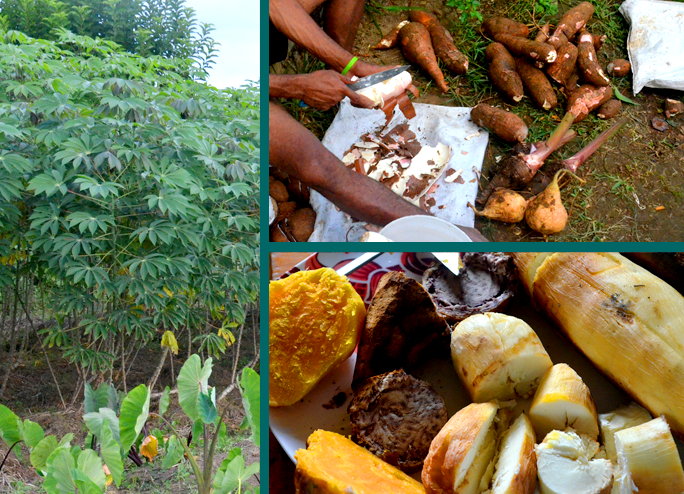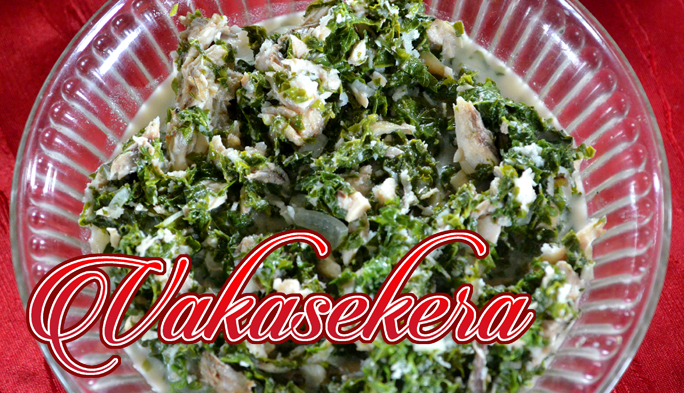Vakasekera
In and all around Fiji, it’s easy to
spot cassava plants. It’s a unique kind of skinny plant that has
enormously large roots that are cooked sort of like potatoes. I
try not to eat the roots. I never liked them in Africa and I see
no need to try them elsewhere. However, I love cassava
leaves. So, when I spy that skinny plant, I always ask about
recipes.
As it turns out, lots of people in Fiji do not eat the cassava leaves. However, people from the islands of Lau Province have a cassava leaf specialty called vakasekera (vah kah sah CARE aah). And, Alena Nalawa, one of my gracious hosts, was from Lau. Lucky me!
As it turns out, lots of people in Fiji do not eat the cassava leaves. However, people from the islands of Lau Province have a cassava leaf specialty called vakasekera (vah kah sah CARE aah). And, Alena Nalawa, one of my gracious hosts, was from Lau. Lucky me!
Vakasekera
Alena Nalawa, Kuku, Fiji
Alena Nalawa, Kuku, Fiji
| 4 lbs of cassava leaves 2 pounds fresh tuna 1 medium onion, diced |
any seafood you may want lolo or 3 can coconut milk... salt to taste |
Yes, I know that four pounds of cassava leaves sounds like a lot. But after you pick off the stems and put them through a blender, it’s not nearly as much as you might suspect. Now, if we were making this in Africa, you’d need a mortar and pestle to pound up those leaves. But in Fiji, mentioning that to people really amused them. Those kitchen tools are mostly used in the preparation of the national drink, kava. So, use your blender with no guilt. However, Alena didn’t have electricity. I did not see the preparation of her vakasekera, but I’m guessing she rolled the leaved and then finely sliced those little rolls.
Boil up some hot water, and when all your cassava leaves are ready, toss them in the pot. Continue boiling everything for ten minutes and stir frequently. Afterwards, drain off the water, rinse the cassava leaves in cold water, and then squeeze dry the leaves into two balls in order to get out as much excess water as possible. If you forget that second step about the cold rinse, you’ll burn your hands. Burnt fingers are not a part of this recipe, so follow all the steps.
Meanwhile, in a separate pot, boil up your tuna. When it’s ready, debone the fish, and find yet another clean pot in your kitchen. Mix in the tuna, the diced onion, any other seafood you may want in the dish (optional), lolo, and salt to taste. Bring the mixture to a boil over a low heat. When you start to see bubbles in your lolo, it is time to add in the cassava leaves. Bring it back to a boil and cook for five minutes.
 Skinny cassava plants, preparation, and
cooked sweet potatoes, taro, and cassava roots
Skinny cassava plants, preparation, and
cooked sweet potatoes, taro, and cassava rootsServe up your vakasekera with cassava roots (if you can tolerate them) or prepare rice or taro. Yes, you could also use potatoes, but I think that’s done in Ohio and not Fiji.
If this really interests you, I’m quite sure you can find cassava leaves in African and Asian shops in your community. However, I’m guessing you could successfully substitute the cassava leaves for other greens at your local market like spinach or kale. It won’t exactly be vakasekera, but you will have an evening dinner experience with interesting conversation.
